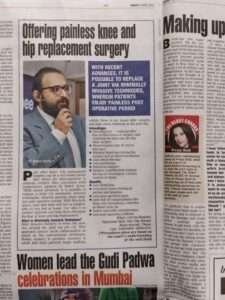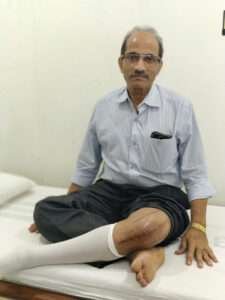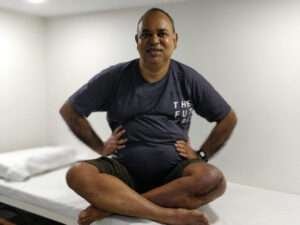Vitamin D Deficiency in Urban Population

Vitamin D is one of the most essential nutrients that human body needs for proper functioning. Vitamin D is also known as “Sunshine Vitamin” and it can be taken from diet but the Sunlight is the greatest source of vitamin D. It is vital for absorption of calcium. Vitamin D deficiency increases the risk of fracture and poor healing after fracture.
As per the doctors’ opinion, In India more than half of urban population is suffering from vitamin D deficiency. Daily new patients are diagnosed with the deficiency in urban areas. Vitamin D deficiency is not restricted to adults only because infants are also diagnosed with the shortage due to lack of Vitamin D in their mother’s milk. This is an alarming condition for the country.
Vitamin D deficiency is widely found in urban population irrespective of their age and gender. The most disturbing fact is that the Vitamin D deficiency is rapidly spreading among youngsters and adults living in urban areas due to lack of awareness. If this speed continues in future then it can be termed as an epidemic.
Vitamin D deficiency makes the body vulnerable to various diseases such as:
- Cancer
- Osteoporosis
- Rickets
- Cardiovascular diseases
- Risk of developing Diabetes
- Obesity
- Psychological disorders like Depression, Hypertension etc.
Vitamin D is very important for various roles in the body including:
- Maintaining strong bones and teeth.
- Boosting the health of the immune system, brain and nervous system.
- Regulating insulin
- Helping in proper diabetes
- Supporting lung function and cardiovascular health.
- Slowing the cancer development.

Common Symptoms of Vitamin D Deficiency:
- Multiple bony or muscular pains.
- Easily fatigability.
- Reduced stamina.
- Not feeling fresh after sleeping.
- Nonspecific back pain/cramps.
Reasons of Vitamin D Deficiency in Urban Population:
There are various reasons due to which vitamin D deficiency is occurring in urban population. Major reasons are:
- Digital Addiction is one of the major causes of vitamin D deficiency and it primarily involves over- using of mobile phones and other digital gadgets. Nowadays most of the children, youngsters as well as adults especially in urban areas are excessively using smart phones. Example: Playing games on mobile, watching movies on mobile etc. Today, even children prefer to play games on mobile phone instead of going outside for playing outdoor games. This factor reduces the chances of getting enough sunlight on the skin and due to lack of exposure to sunlight, vitamin D deficiency is mostly found in urban people.
- In India, dairy products are widely consumed by the people but they are rarely fortified with vitamin D. It can also cause vitamin D deficiency.
- Various foods such as dairy products, cod liver oil, mushrooms, egg yolk and fishes contain ample amount of vitamin D. As per the survey, people living in urban areas eat junk foods often which can cause vitamin D deficiency.
- People with darker skin have less ability to absorb the ultraviolet radiation B (UVB) rays from the sun which are essential to produce vitamin D.
- An excessive use of sunscreen and clothing covering entire body reduce the body’s ability synthesize the vitamin D thus finally causing deficiency of vitamin D.
- Sometimes, high pollution especially in urban areas obstructs the sunlight from reaching the ground. Smogis a type of severe air Due this condition, people do not get sufficient sunlight causing vitamin D deficiency.
- Vitamin D Deficiency is also occurred in people who work at night and stay at home during whole day. These people should take effective measures for getting sufficient vitamin D.
Although vitamin D supplement is taken by the people but the natural sunlight especially during early morning is a greatest source of vitamin D. Excessive consumption of vitamin D supplement can lead to over calcification of bones as well as hardening of blood vessels, kidney, lungs and heart. Hence it is always advisable to get required Vitamin D from natural source.
Thank You "Times Group" for felicitating Arora Clinic for "Excellence in Patient Care"
We are really honored to receive this and we will continue to serve the society better than ever We aim to provide the world-class Knee/Hip Replacement Surgical (Minimal Invasive Surgery) treatment to every patient suffering from knee or hip pain and at the same time make their life pain-free and happy.
Our Services
Are you looking for Best Knee Replacement Surgeon?
Then you are at Right Place

Dr. Bakul Arora’s Joint Replacement Clinic is also known as “Arora Clinic” which is located at Hiranandani Meadows in Thane, within a very convenient proximity to Mumbai. Arora Clinic dedicated clinic for Knee Replacement surgery and all kinds of Orthopaedic treatments and surgeries
The Arora Clinic is one of the most advanced Orthopaedic clinic in Thane region and dedicated to providing the best, personalised healthcare with a breadth of surgical and medical expertise. Arora Clinic offers the modern surgical treatments like “Minimally Invasive Knee Replacement Surgery” which is also called as “PAIN-LESS SURGERY” for any complex knee diseases.
About Surgeon
Dr. Bakul Arora is a Consultant Joint Replacement & Orthopaedic Surgeon is one of the leading Knee Replacement Surgeon in Thane and Mumbai with over 4000+ successfully surgeries. Dr. Bakul Arora specialises in Mini-invasive techniques which offer multiple benefits to patients. He does the surgery using Subvastus approach for Knee Replacement surgery and Direct Anterior Approach for Hip replacement Surgery . This new techniques has many advantages for patients like its pain-less , stich-less surgery, patients walks on the same day after surgery, no blood loss, faster recovery etc.


Patients Review on Arora Clinic
International Patients Videos
FAQS
Knee replacement is required for advanced arthritis of the knee joint, producing painful limitation of movements and restriction in activities of daily living. Knee replacement as a solution should be offered when all non–surgical methods of treatment failed and painkiller medicines and injections also failed to reduce the Knee and hip pains.
Knee replacement can be total or unicondylar, depending on the number of compartments involved. Among the total knee replacement, there are two popular designs- Cruciate Retaining, and Posterior Stabilized. The decision for the design is best taken by the operating orthopedic surgeon based on the integrity of ligaments. Patella resurfacing as a routine is a debatable subject.
Yes, most knee replacement surgeries are minimally invasive, with numerous benefits to the patient, including smaller incisions, less tissue trauma, bleeding and post–operative pain, shorter hospital stays, faster recovery, and earlier return to work and activities — in weeks rather than months. Advantages of Minimally Invasive Knee Replacement Surgery. Patients Start walking in few hours of surgery. Patients start climbing the staircase from second day of his surgery. Patients Discharge with in 3 Days from the Hospital after surgery. No blood loss during the surgery, no blood Transfusion required. Less Physiotherapy.( No Physiotherapist required for home) Less Antibiotic. Stitchless Surgery. Recovery time is just two – three week.
Bilateral knee replacement in the same sitting, can be performed if both the knee joints are damaged to the same extent, however, the medical condition of the patient, and bone quality must be kept in consideration.
Surgery through Minimally Invasive technique patients start walking on the same day and staircase climbing starts from the second day of surgery. Patients can resume his work after 3 – 4 week.
The most significant risks include Infection, Deep vein thrombosis,and Aseptic loosening of implants. The risks correlate with the co-morbid medical condition, and must be discussed with the patient before surgery.
Patients normally require hospitalization for 3-4 days in single knee replacement, and up to 5-6 days in both knee replacement surgery
A single knee replacement takes approximately 90 min- 2 hours. Both knee replacement surgery takes approx 2-3 hours.
Years ago, knee replacement surgery was reserved for elderly patients due to a high complication rate and lack of implant durability. Modern techniques have allowed orthopaedic surgeons to base surgical decisions on a patient’s pain and disability, and not necessarily chronological age. Most patients who undergo knee replacement are between the ages of 50 and 80, but surgeons evaluate patients individually and primarily on their physiologic age and demands.
Patients can resume his/her light work after discharge from the hospital, no need for rest.
Patients are given epidural anesthesia for surgery, and post op pain relief. They are expected to follow instruction from physiotherapist regarding muscle training.
News Events




Locate Our Clinic
OUR HOSPITAL PARTNERS
MUMBAI
⇒ Wockhardt Hospital Mumbai Central, Mira road & Vashi
⇒ Apollo Spectra Hospital, Tardeo and Chembur
⇒ Cloud 9 Hospital, Malad
⇒ Criticare Hospital, Andheri
THANE
⇒ Arora Clinic, Hiranandani Meadows
⇒ Bethany Hospital, Vasant Vihar
⇒ Currae Hospital, Kapurbawdi
⇒ Horizon Hospital, Ghodbunder
⇒ Infinity Hospital, Majiwada
⇒ Lakecity Hospital, Khopat
⇒ Oscar Hospital, Majiwada
⇒ Drone Hospital, Bhiwandi

















